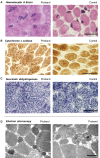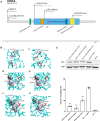Bi-allelic variants in CHKA cause a neurodevelopmental disorder with epilepsy and microcephaly
- PMID: 35202461
- PMCID: PMC9630884
- DOI: 10.1093/brain/awac074
Bi-allelic variants in CHKA cause a neurodevelopmental disorder with epilepsy and microcephaly
Abstract
The Kennedy pathways catalyse the de novo synthesis of phosphatidylcholine and phosphatidylethanolamine, the most abundant components of eukaryotic cell membranes. In recent years, these pathways have moved into clinical focus because four of ten genes involved have been associated with a range of autosomal recessive rare diseases such as a neurodevelopmental disorder with muscular dystrophy (CHKB), bone abnormalities and cone-rod dystrophy (PCYT1A) and spastic paraplegia (PCYT2, SELENOI). We identified six individuals from five families with bi-allelic variants in CHKA presenting with severe global developmental delay, epilepsy, movement disorders and microcephaly. Using structural molecular modelling and functional testing of the variants in a cell-based Saccharomyces cerevisiae model, we determined that these variants reduce the enzymatic activity of CHKA and confer a significant impairment of the first enzymatic step of the Kennedy pathway. In summary, we present CHKA as a novel autosomal recessive gene for a neurodevelopmental disorder with epilepsy and microcephaly.
Keywords: Kennedy pathway; choline kinase alpha; epilepsy; exome sequencing; neurodevelopmental disorder.
© The Author(s) 2022. Published by Oxford University Press on behalf of the Guarantors of Brain. All rights reserved. For permissions, please e-mail: journals.permissions@oup.com.
Figures


Similar articles
-
Bi-allelic PAGR1 variants are associated with microcephaly and a severe neurodevelopmental disorder: Genetic evidence from two families.Am J Med Genet A. 2022 Jan;188(1):336-342. doi: 10.1002/ajmg.a.62513. Epub 2021 Sep 29. Am J Med Genet A. 2022. PMID: 34585832
-
Bi-allelic loss-of-function variants in PPFIBP1 cause a neurodevelopmental disorder with microcephaly, epilepsy, and periventricular calcifications.Am J Hum Genet. 2022 Aug 4;109(8):1421-1435. doi: 10.1016/j.ajhg.2022.06.008. Epub 2022 Jul 12. Am J Hum Genet. 2022. PMID: 35830857 Free PMC article.
-
Biallelic variants in ZNF526 cause a severe neurodevelopmental disorder with microcephaly, bilateral cataract, epilepsy and simplified gyration.J Med Genet. 2022 Mar;59(3):262-269. doi: 10.1136/jmedgenet-2020-107430. Epub 2021 Jan 4. J Med Genet. 2022. PMID: 33397746
-
YIF1B-related Kaya-Barakat-Masson Syndrome: Report of a new patient and literature review.Eur J Med Genet. 2023 Jun;66(6):104751. doi: 10.1016/j.ejmg.2023.104751. Epub 2023 Mar 21. Eur J Med Genet. 2023. PMID: 36948290 Review.
-
Megaconial congenital muscular dystrophy due to novel CHKB variants: a case report and literature review.Skelet Muscle. 2022 Sep 29;12(1):23. doi: 10.1186/s13395-022-00306-8. Skelet Muscle. 2022. PMID: 36175989 Free PMC article. Review.
Cited by
-
Prenatal phenotype of PNKP-related microcephaly, seizures, and developmental delay: A case report and literature review.Medicine (Baltimore). 2025 Jan 17;104(3):e41300. doi: 10.1097/MD.0000000000041300. Medicine (Baltimore). 2025. PMID: 39833032 Free PMC article. Review.
-
Selenoprotein I (selenoi) as a critical enzyme in the central nervous system.Arch Biochem Biophys. 2022 Oct 30;729:109376. doi: 10.1016/j.abb.2022.109376. Epub 2022 Aug 22. Arch Biochem Biophys. 2022. PMID: 36007576 Free PMC article.
-
Glycerophospholipids: Roles in Cell Trafficking and Associated Inborn Errors.J Inherit Metab Dis. 2025 Mar;48(2):e70019. doi: 10.1002/jimd.70019. J Inherit Metab Dis. 2025. PMID: 40101691 Free PMC article. Review.
-
Choline kinase alpha genotype is related to hippocampal brain volume and cognition in postmenopausal women.Heliyon. 2023 Dec 22;10(1):e23963. doi: 10.1016/j.heliyon.2023.e23963. eCollection 2024 Jan 15. Heliyon. 2023. PMID: 38226229 Free PMC article.
-
In Cerebellar Atrophy of 12-Month-Old ATM-Null Mice, Transcriptome Upregulations Concern Most Neurotransmission and Neuropeptide Pathways, While Downregulations Affect Prominently Itpr1, Usp2 and Non-Coding RNA.Cells. 2023 Oct 3;12(19):2399. doi: 10.3390/cells12192399. Cells. 2023. PMID: 37830614 Free PMC article.
References
-
- Gibellini F, Smith TK. The Kennedy pathway—De novo synthesis of phosphatidylethanolamine and phosphatidylcholine. IUBMB Life. 2010;62(6):414–428. - PubMed
-
- Aoyama C, Yamazaki N, Terada H, Ishidate K. Structure and characterization of the genes for murine choline/ethanolamine kinase isozymes α and β. J Lipid Res. 2000;41(3):452–464. - PubMed
-
- Liao H, Aoyama C, Ishidate K, Teraoka H. Deletion and alanine mutation analyses for the formation of active homo- or hetero-dimer complexes of mouse choline kinase-α and -β. Biochim Biophys Acta. 2006;1761(1):111–120. - PubMed
-
- Bardhan M, Polavarapu K, Bevinahalli NN, et al. Megaconial congenital muscular dystrophy secondary to novel CHKB mutations resemble atypical Rett syndrome. J Hum Genet. 2021;66:813–823. - PubMed
Publication types
MeSH terms
Substances
Grants and funding
LinkOut - more resources
Full Text Sources
Medical
Molecular Biology Databases
Research Materials

